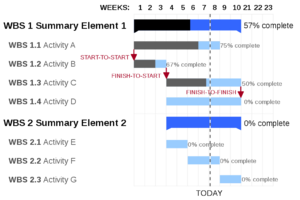Project scheduling and time management: tips and tricks
| Line 40: | Line 40: | ||
===Identifying task dependencies=== | ===Identifying task dependencies=== | ||
---- | ---- | ||
| − | [[File:task-dependencies.png|thumb| | + | [[File:task-dependencies.png|thumb|Visualized task dependencies types and order for effective project management.|200px]] |
Identifying task dependencies is a critical step in project management, as it helps to ensure that tasks are completed in the correct order and that project timelines are met. Task dependencies can be classified into different types based on when predecessor and successor tasks occur, such as Finish to Start, Finish to Finish, Start to Start, and Start to Finish[https://teamhood.com/project-management-resources/task-dependencies/]. | Identifying task dependencies is a critical step in project management, as it helps to ensure that tasks are completed in the correct order and that project timelines are met. Task dependencies can be classified into different types based on when predecessor and successor tasks occur, such as Finish to Start, Finish to Finish, Start to Start, and Start to Finish[https://teamhood.com/project-management-resources/task-dependencies/]. | ||
| Line 46: | Line 46: | ||
This can be done through a variety of methods, such as brainstorming sessions with team members, project planning software, and project management frameworks like the critical path method. By effectively identifying task dependencies, project managers can ensure that their projects are completed on time and to the desired quality standards. | This can be done through a variety of methods, such as brainstorming sessions with team members, project planning software, and project management frameworks like the critical path method. By effectively identifying task dependencies, project managers can ensure that their projects are completed on time and to the desired quality standards. | ||
| + | |||
| + | |||
| + | |||
| + | |||
| + | == '''Resource Allocation''' == | ||
| + | Resource allocation is a crucial aspect of project management that involves identifying, assigning, and scheduling available resources such as people, equipment, and materials to specific tasks and activities. The ultimate goal of resource allocation is to ensure that a project is completed within the stipulated time frame, budget, and quality standards. The process requires a thorough understanding of the availability of resources, their capabilities, and the demands of the project. Effective resource allocation involves prioritizing the allocation of resources to the most critical activities and identifying the right resources, including team members, tools, and budget, to maximize the impact of the project resources.[https://asana.com/resources/resource-allocation] | ||
| + | ===Allocating human resources=== | ||
| + | ---- | ||
Revision as of 18:31, 18 February 2023
Contents |
Project scheduling and time management: tips and tricks
Project scheduling and time management is a critical aspect of project management, as it helps to ensure that projects are completed on time, within budget and to the required quality standards. Time management involves a range of activities, including defining the project schedule, determining the tasks required to complete the project, estimating the time required for each task, and creating a timeline for the project.
One of the main goals of project scheduling is to develop a detailed plan that outlines the timeline and dependencies of tasks, and identifies the critical path of the project. This critical path represents the sequence of tasks that must be completed on time in order to meet the project deadline. By understanding the critical path, project managers can focus their efforts on ensuring that tasks along the critical path are completed on time, and can also identify any potential delays or issues that may impact the project timeline.
Effective time management also requires careful consideration of resource allocation, including the allocation of both human and material resources. Project managers need to ensure that the right people are available to complete tasks at the right time, and that sufficient resources are available to support project activities. This may involve negotiating with stakeholders and suppliers to secure resources, and monitoring resource utilization throughout the project. To be successful, project scheduling and time management requires a combination of technical skills and interpersonal skills, including effective communication, collaboration, and problem-solving abilities. Project managers need to be able to work closely with their team, stakeholders and suppliers to identify potential risks and issues, and to develop and implement effective solutions.
In conclusion, project scheduling and time management play a critical role in ensuring project success, and are essential skills for any project manager. By carefully planning and managing the timeline of a project, project managers can help to ensure that projects are completed on time, within budget, and to the required quality standards.
Introduction to project and time management
Definition of project scheduling and time management
Project scheduling and time management are critical components of project management that involve planning, organizing, and controlling project activities to achieve specific goals and objectives within a defined timeframe. The aim is to ensure that projects are completed on time, within budget, and to the required quality standards by estimating time required for tasks, allocating resources effectively, and identifying the critical path of tasks. Effective project scheduling and time management require technical and interpersonal skills, including communication, collaboration, and problem-solving abilities.
Importance of project scheduling and time management in project success
Effective project scheduling and time management are essential for project success. They help to ensure that projects are completed on time, within budget, and to the required quality standards. By planning and managing the timeline of a project, project managers can identify potential issues and risks, allocate resources effectively, and focus their efforts on critical tasks. This increases the chances of meeting project objectives and delivering successful project outcomes.
Project Scheduling
Project scheduling involves defining the tasks, milestones, and deliverables required to complete a project and determining the sequence of these tasks. It helps to create a roadmap for the project and identifies the critical path of tasks that must be completed on time to meet project deadlines.
Outlining the project timeline
Outlining a project involves breaking it down into smaller, manageable tasks that are easier to estimate, plan and manage. This helps to create a clearer understanding of the project requirements and determine the resources and budget needed. The following are some examples and illustration opportunities of outlining a project:
- Work Breakdown Structure (WBS): A WBS is a hierarchical decomposition of the project scope into smaller and more manageable components. A WBS starts with the overall project objective and breaks it down into smaller, more detailed tasks. This helps to create a clear and organized picture of the project scope and timeline.
- Mind Mapping: Mind mapping is a graphical tool that can be used to break down complex information into smaller, more manageable pieces. It is a visual tool that helps to organize and structure information, identify relationships between different elements, and make connections between ideas. Mind mapping can be a useful tool for outlining a project and identifying the tasks and deliverables required to complete it.
- Gantt Chart: A Gantt chart is a graphical representation of a project schedule that shows the sequence of tasks and their timelines. A Gantt chart can be used to outline a project by breaking it down into smaller, manageable tasks and creating a visual representation of the project timeline. It helps to identify the critical path of tasks that must be completed on time to meet project deadlines.
- Agile Development: Agile development is an iterative and flexible approach to project management that emphasizes collaboration, customer satisfaction, and continuous improvement. It involves breaking down a project into smaller, more manageable components called sprints, which are completed in short timeframes. Agile development can be a useful approach for outlining a project as it allows for more flexibility and adaptability in project planning and management.
These are just a few examples of outlining a project, and there are many other tools and approaches that can be used depending on the specific project and its requirements. The key is to break the project down into smaller, more manageable tasks that can be estimated, planned and managed effectively.
Determining the critical path
To determine the critical path, project managers need to identify all the tasks involved in a project, estimate their durations, and sequence them in the order in which they need to be completed. Once this information is available, the total duration of the project can be calculated and the tasks critical to completing the project on time can be identified.
The critical path is the sequence of tasks that must be completed on time in order to meet the project deadline. These tasks are critical because any delay in completing them will delay the entire project. To determine the critical path, the tasks with the longest duration must be identified, and then the tasks dependent on them should be determined. The critical path will be the sequence of tasks that has the longest duration and no slack time. One way to determine the critical path is to use a Gantt chart. A Gantt chart can help project managers identify the critical path by highlighting the tasks that have zero slack time and cannot be delayed without delaying the entire project.[1]
It's important to note that the critical path can change over the course of the project, as tasks are completed ahead of or behind schedule. Therefore, project managers need to regularly monitor the progress of the project and make adjustments as necessary to ensure that the critical path is still accurate.
Identifying task dependencies
Identifying task dependencies is a critical step in project management, as it helps to ensure that tasks are completed in the correct order and that project timelines are met. Task dependencies can be classified into different types based on when predecessor and successor tasks occur, such as Finish to Start, Finish to Finish, Start to Start, and Start to Finish[2].
Identifying these dependencies can help project managers to avoid task mismanagement throughout the project timeline, which contributes to 12% of project failures[[3]]. It can also help to increase the likelihood of on-time project delivery by identifying critical paths and any potential bottlenecks in the project schedule[4]. In order to effectively identify task dependencies, project managers need to have a clear understanding of the project goals and objectives, as well as the specific tasks required to achieve those objectives.
This can be done through a variety of methods, such as brainstorming sessions with team members, project planning software, and project management frameworks like the critical path method. By effectively identifying task dependencies, project managers can ensure that their projects are completed on time and to the desired quality standards.
Resource Allocation
Resource allocation is a crucial aspect of project management that involves identifying, assigning, and scheduling available resources such as people, equipment, and materials to specific tasks and activities. The ultimate goal of resource allocation is to ensure that a project is completed within the stipulated time frame, budget, and quality standards. The process requires a thorough understanding of the availability of resources, their capabilities, and the demands of the project. Effective resource allocation involves prioritizing the allocation of resources to the most critical activities and identifying the right resources, including team members, tools, and budget, to maximize the impact of the project resources.[5]

